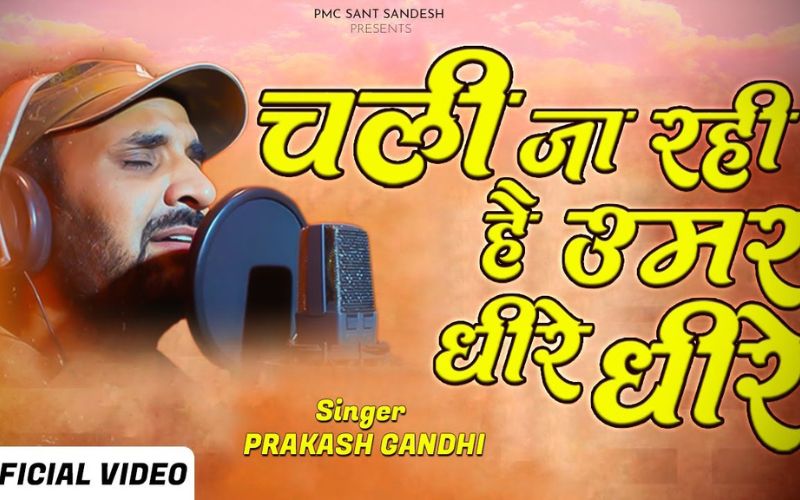“Chali Ja Rahi Hai Umar Dheere Dheere” is a poignant and introspective song that has captured the hearts of music lovers across generations. This timeless melody, with its soulful lyrics and haunting melody, has become a beloved classic in the Indian music landscape. The song’s title, which translates to “Time is Slipping Away Slowly,” reflects the profound and universal themes of the passage of time, the fleeting nature of life, and the bittersweet realization of our own mortality.
The song’s enduring appeal lies in its ability to resonate with listeners on a deep, emotional level. Whether you’re young or old, the lyrics of “Chali Ja Rahi Hai Umar Dheere Dheere” have a way of stirring the soul, prompting introspection and a renewed appreciation for the precious moments we often take for granted. In this article, we’ll delve into the rich tapestry of this beloved song, exploring its lyrics, the meaning behind them, and the impact it has had on the music industry and popular culture.
Understanding the lyrics of “Chali Ja Rahi Hai Umar Dheere Dheere”
The lyrics of “Chali Ja Rahi Hai Umar Dheere Dheere” are a poetic masterpiece, crafted with a remarkable depth of emotion and a keen understanding of the human experience. Each verse and chorus is imbued with a sense of melancholy and wistfulness, as the singer grapples with the relentless passage of time and the realization that life is fleeting.
The opening lines set the tone, with the singer lamenting, “Chali ja rahi hai umar dheere dheere,” which translates to “Time is slipping away slowly.” This simple yet profound statement encapsulates the central theme of the song – the awareness that our lives are finite, and that each moment we experience is precious and irreplaceable.
As the song progresses, the lyrics delve deeper into the human experience, touching on themes of nostalgia, regret, and the bittersweet nature of life. The singer reflects on the moments that have slipped through their fingers, the opportunities missed, and the dreams that have faded with the passage of time. The chorus, with its haunting refrain, serves as a poignant reminder of the fleeting nature of our existence.
The meaning behind the lyrics of “Chali Ja Rahi Hai Umar Dheere Dheere”
The lyrics of “Chali Ja Rahi Hai Umar Dheere Dheere” are not merely a collection of words; they are a tapestry of profound and universal truths about the human condition. At its core, the song is a meditation on the relentless march of time and the inevitable process of aging and mortality.
The title itself, “Chali Ja Rahi Hai Umar Dheere Dheere,” conveys a sense of resignation and acceptance, as the singer acknowledges the inexorable passage of time. The use of the phrase “dheere dheere” (slowly) adds a sense of melancholy and poignancy, underscoring the bittersweet nature of this journey.
Throughout the lyrics, the singer grapples with the realization that the moments and experiences that once seemed endless are now slipping away, like grains of sand through their fingers. The references to “khwabon ke pankh” (wings of dreams) and “khushiyon ke rang” (colors of happiness) evoke a sense of nostalgia and the fleeting nature of joy and fulfillment.
Ultimately, the lyrics of “Chali Ja Rahi Hai Umar Dheere Dheere” serve as a poignant reminder to cherish the present moment and to embrace the beauty and fragility of life. The song encourages listeners to reflect on their own experiences, to savor the precious moments they have, and to find meaning and purpose in the face of the relentless march of time.
Popular renditions and covers of “Chali Ja Rahi Hai Umar Dheere Dheere”
“Chali Ja Rahi Hai Umar Dheere Dheere” has become a beloved classic, inspiring numerous renditions and covers by talented artists across various genres and generations. The song’s enduring appeal has led to a rich tapestry of interpretations, each offering a unique perspective and emotional resonance.
One of the most popular and acclaimed renditions of the song is the original version, performed by the legendary singer Lata Mangeshkar. Mangeshkar’s ethereal vocals and emotive delivery have cemented the song’s status as a timeless masterpiece, capturing the essence of the lyrics with unparalleled grace and artistry.
In addition to Mangeshkar’s iconic version, the song has also been covered by a diverse array of artists, each bringing their own unique style and interpretation. From soulful acoustic renditions to contemporary electronic remixes, the versatility of “Chali Ja Rahi Hai Umar Dheere Dheere” has allowed it to transcend genres and appeal to a wide range of music enthusiasts.
One notable cover that has gained significant attention is the version performed by the renowned classical vocalist Pandit Hariprasad Chaurasia. Chaurasia’s mesmerizing flute rendition, with its haunting melodies and intricate improvisations, has added a new layer of depth and spirituality to the song, captivating audiences and showcasing the universal appeal of the lyrics.
These diverse interpretations of “Chali Ja Rahi Hai Umar Dheere Dheere” have not only kept the song alive but have also contributed to its enduring legacy, demonstrating the timeless and versatile nature of this musical masterpiece.
The impact and reception of “Chali Ja Rahi Hai Umar Dheere Dheere”
“Chali Ja Rahi Hai Umar Dheere Dheere” has had a profound and lasting impact on the music industry and popular culture, resonating with audiences across generations and transcending linguistic and cultural boundaries.
The song’s universal themes of mortality, nostalgia, and the fleeting nature of life have struck a chord with listeners worldwide, making it a beloved classic that continues to captivate and inspire. The poignant lyrics and haunting melody have become woven into the fabric of Indian cultural consciousness, with the song being widely recognized as a timeless masterpiece.
The impact of “Chali Ja Rahi Hai Umar Dheere Dheere” can be seen in its widespread recognition and critical acclaim. The song has been lauded by music critics and scholars alike, who have praised its artistic merit, emotional depth, and its ability to transcend the boundaries of traditional music. The song has also been the subject of numerous academic studies and analyses, further cementing its status as a cultural touchstone.
Beyond the realm of music, “Chali Ja Rahi Hai Umar Dheere Dheere” has also found its way into various forms of popular culture, from literature and cinema to visual arts and poetry. The song’s evocative imagery and profound themes have inspired creative interpretations and adaptations, further expanding its reach and influence.
The enduring legacy of “Chali Ja Rahi Hai Umar Dheere Dheere” is a testament to the power of music to connect with the human experience, to evoke emotions, and to transcend the limitations of time and space. As the song continues to captivate and inspire audiences, it serves as a reminder of the enduring impact that a truly great work of art can have on the world.
Exploring the artist behind “Chali Ja Rahi Hai Umar Dheere Dheere”
The masterpiece that is “Chali Ja Rahi Hai Umar Dheere Dheere” is the result of the collaborative efforts of several talented artists who have left an indelible mark on the Indian music landscape.
At the heart of the song’s creation is the legendary singer Lata Mangeshkar, whose ethereal vocals and emotive interpretation have become synonymous with the song’s enduring appeal. Mangeshkar’s ability to convey the depth of emotion and the nuances of the lyrics has been widely praised, cementing her status as one of the greatest vocalists of all time.
Alongside Mangeshkar, the song’s lyrics were penned by the renowned poet and lyricist Majrooh Sultanpuri, whose mastery of the Urdu language and keen understanding of the human experience have contributed immensely to the song’s poetic brilliance.
The music for “Chali Ja Rahi Hai Umar Dheere Dheere” was composed by the acclaimed music director Sachin Dev Burman, whose melodic sensibilities and ability to capture the essence of the lyrics have been instrumental in the song’s enduring popularity.
The collaborative efforts of these artists, each with their own distinct talents and contributions, have resulted in the creation of a timeless masterpiece that continues to captivate and inspire audiences across generations. The seamless integration of Mangeshkar’s vocals, Sultanpuri’s lyrics, and Burman’s music has created a synergy that transcends the individual components, giving rise to a work of art that is greater than the sum of its parts.
As we delve into the rich tapestry of “Chali Ja Rahi Hai Umar Dheere Dheere,” it is important to recognize and celebrate the incredible talent and dedication of the artists who have poured their hearts and souls into this beloved song, ensuring its enduring legacy in the annals of Indian music.
Interesting facts and trivia about “Chali Ja Rahi Hai Umar Dheere Dheere”
“Chali Ja Rahi Hai Umar Dheere Dheere” is a song that is not only beloved for its musical and lyrical brilliance but also for the fascinating stories and trivia that surround its creation and legacy. Here are some interesting facts and tidbits about this timeless classic:
- Original Release: The song was first released in 1956 as part of the soundtrack for the Bollywood film “Funtoosh,” directed by Hrishikesh Mukherjee.
- Legendary Collaborations: The creative team behind “Chali Ja Rahi Hai Umar Dheere Dheere” was a who’s who of Indian music legends, including Lata Mangeshkar, Majrooh Sultanpuri, and Sachin Dev Burman.
- Alternate Titles: The song is also known by the titles “Jiya Jale Jaan-E-Jaan” and “Jiya Jale,” which are often used interchangeably with the original title.
- Multilingual Adaptations: The song has been adapted and covered in various regional languages, including Bengali, Punjabi, and Gujarati, further expanding its reach and appeal.
- Iconic Performances: Over the years, the song has been performed live by numerous legendary artists, including Lata Mangeshkar, Pandit Hariprasad Chaurasia, and Shreya Ghoshal, each offering a unique interpretation.
- Awards and Accolades: “Chali Ja Rahi Hai Umar Dheere Dheere” has been the recipient of numerous awards and accolades, including the Filmfare Award for Best Playback Singer (Female) for Lata Mangeshkar’s rendition.
- Spiritual Connections: The song’s profound themes and haunting melodies have led to it being associated with various spiritual and philosophical traditions, with some listeners finding solace and inspiration in its message.
These fascinating facts and trivia serve as a testament to the enduring legacy of “Chali Ja Rahi Hai Umar Dheere Dheere,” a song that has transcended the boundaries of time and space to become a cherished part of India’s cultural heritage.
How “Chali Ja Rahi Hai Umar Dheere Dheere” became a cultural phenomenon
The enduring popularity and cultural significance of “Chali Ja Rahi Hai Umar Dheere Dheere” can be attributed to a confluence of factors that have contributed to its status as a true cultural phenomenon.
At the heart of the song’s appeal is its ability to resonate with audiences on a deeply personal and emotional level. The universal themes of mortality, nostalgia, and the fleeting nature of life that are so poignantly expressed in the lyrics have struck a chord with listeners across generations, transcending linguistic and cultural boundaries.
The song’s timeless melody, combined with Lata Mangeshkar’s iconic vocal performance, has also played a crucial role in its ascent to cultural prominence. The seamless integration of the lyrics, music, and vocals has created a synergy that has captivated audiences and cemented the song’s status as a musical masterpiece.
Moreover, the collaborative efforts of the creative team behind “Chali Ja Rahi Hai Umar Dheere Dheere” – the legendary lyricist Majrooh Sultanpuri, the acclaimed composer Sachin Dev Burman, and the incomparable Lata Mangeshkar – have lent the song an aura of artistic excellence that has further contributed to its cultural significance.
The song’s enduring presence in popular culture, from its inclusion in numerous Bollywood films to its frequent use in various forms of media, has also played a crucial role in its transformation into a cultural phenomenon. The song’s ability to transcend the boundaries of its original context and resonate with audiences in diverse settings has solidified its status as a timeless classic.
Ultimately, the cultural impact of “Chali Ja Rahi Hai Umar Dheere Dheere” can be attributed to its ability to touch the hearts and souls of listeners, to evoke a sense of nostalgia and reflection, and to serve as a poignant reminder of the fleeting nature of our existence. It is this profound and universal appeal that has cemented the song’s status as a true cultural phenomenon, one that will continue to captivate and inspire audiences for generations to come.
The legacy and significance of “Chali Ja Rahi Hai Umar Dheere Dheere” in the music industry
“Chali Ja Rahi Hai Umar Dheere Dheere” has left an indelible mark on the Indian music industry, cementing its status as a timeless classic that has inspired and influenced countless artists and music enthusiasts.
The song’s enduring popularity and critical acclaim have solidified its position as a benchmark for musical excellence, with its seamless integration of lyrics, melody, and vocals serving as a testament to the artistry and craftsmanship that can be achieved in the realm of Indian music.
Beyond its immediate impact on the music industry, “Chali Ja Rahi Hai Umar Dheere Dheere” has also played a pivotal role in shaping the broader cultural landscape. The song’s profound themes and universal appeal have resonated with audiences across generations, transcending the boundaries of music and becoming woven into the fabric of Indian cultural consciousness.
The legacy of “Chali Ja Rahi Hai Umar Dheere Dheere” can be seen in the countless artists and musicians who have been inspired by its artistry and have sought to emulate its emotional depth and technical mastery. The song’s enduring influence can be heard in the work of contemporary artists who have paid homage to its legacy through their own interpretations and adaptations.
Moreover, the song’s significance extends beyond the realm of music, with its themes and imagery being widely referenced and explored in various forms of art, literature, and popular culture. The song’s ability to transcend the boundaries of its original medium and resonate with audiences in diverse settings is a testament to its cultural significance and enduring legacy.
As we reflect on the legacy of “Chali Ja Rahi Hai Umar Dheere Dheere,” it is clear that this timeless classic has left an indelible mark on the Indian music industry and popular culture. Its enduring popularity, critical acclaim, and cultural impact serve as a testament to the power of music to connect with the human experience, to evoke emotions, and to transcend the limitations of time and space.
If you enjoyed this in-depth exploration of the lyrics and legacy of “Chali Ja Rahi Hai Umar Dheere Dheere,” be sure to check out our other articles that delve into the rich tapestry of Indian music and culture. From classic melodies to contemporary trends, we strive to provide our readers with a comprehensive and insightful perspective on the ever-evolving world of music.





